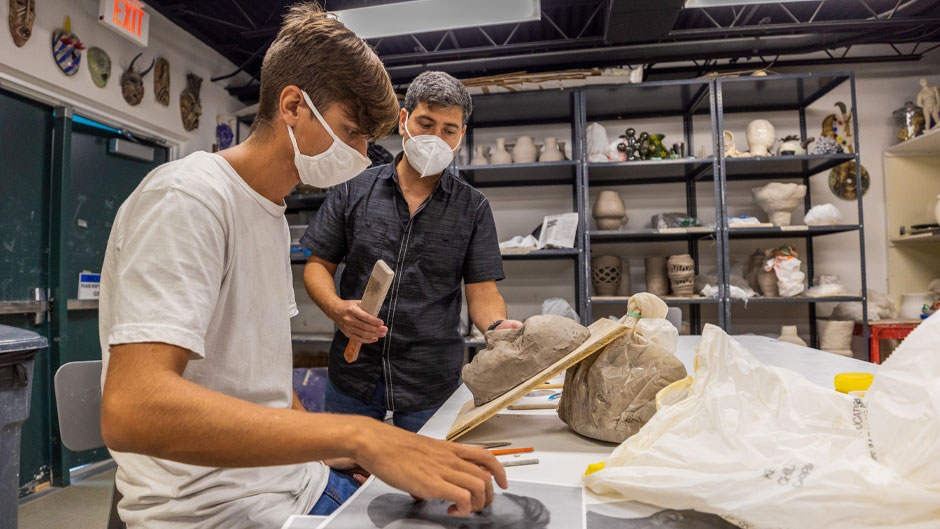While COVID-19 restrictions on in-person interactions have altered the artistic landscape, it has not prevented the creative process for University of Miami student-artists enrolled in “Figure in Clay I” this fall.
While honing their sculpting skills this semester, these students are literally coming face to face with themselves to create a mask that mimics the details of their face.
The class is led in-person by Carlos Prado, a visual artist and lecturer of sculpture and ceramics at the University of Miami, who usually starts by recording a live, 30-minute demonstration that primes everyone for the day’s assignment. So, all students can follow whether they are physically in the classroom or taking the course asynchronously.
“I enter the classroom, get my tools from my locker, fill up my bucket of water, and get the piece I'm working on,” said Gabriela Quiñones, a senior majoring in psychology. “Professor Prado usually does a demonstration or two that we can either see on the projector or take turns looking at, and then we spend the rest of the class sculpting while he walks around to check our technique.”
The classroom is set up for a maximum of six students, so everyone can keep a safe distance from each other, and disinfecting stations are readily available throughout. The students who elected to take the course virtually can join the class in real-time or access the Zoom recording immediately after.
“Everything is very clean and sterile, the class size is very small, and the assigned seating keeps me well-distanced from other classmates,” said Yvette Albelo, a senior BFA painting student. “Interaction with the professor is more personal since the class is so small, which grants me an almost one-on-one course experience.”
Instead of using real life models as they would in a pre-pandemic world, the students were asked to photograph themselves from multiple angles and then examine the intricacies of those images for the structure of the three-dimensional face mask.
“We took photos of our face from multiple perspectives—frontal, profile, and three quarters,” explained Albelo. “The expression is supposed to remain neutral since this assignment is more about achieving accurate features and less about conveying an emotion, as we are still in the early stages of learning how to replicate facial features.”
For Quiñones, this is one of her “favorite classes.” She has developed a very intimate connection with the exploration of her facial details.
“There is something inherently worshipful in sculpting people,” Quiñones noted. “One little part of the face becomes your whole world. I didn't like looking at the pictures of my face for this assignment at first, but the act of making art of myself and trying to see myself in an unbiased way has been nice.”
According to Lance Layman, a second year MFA sculpture student, Prado encourages his students to get creative with their tool selection so that they can achieve more realistic forms. They must keep in mind that using their hands on the clay too often can have a negative effect, because the touch of human skin dries the clay out.
“I am happy to work under the tutelage of Carlos Prado, who I believe is a master of the human form,” Layman said. “I enjoy working on sculpture in person because of the camaraderie in the classroom.’’
Prado firmly believes that art must be interconnected with the needs of society, so in order to make this class a reality for remote students, he spent the summer creating ways to switch from using real clay to a virtual three-dimensional approach.
“The type of classes that I teach are meant to be taught in person, mostly because we have to work with material that requires a hands-on process,” said Prado. “Figure in clay is dedicated to the study of the theory and the representation of the human figure in three-dimensional clay form, so I had to find ways to teach the same content digitally.”
Prado’s solution was to use the 3D modeling computer program known as SculptGL, which mimics the clay modeling process. He successfully crafted a step by step digital sculpting educational booklet that he uses to guide the students who are taking the class asynchronously.
Although life feels differently right now, for Quiñones this has been a time to embrace the obstacles as an opportunity to grow a deeper appreciation for the ability to create and express herself.
“A lot of sweeping statements are made about the nature of human beings, but I think that we all have the desire to create,” Quiñones noted. “Creation can take many forms, and I've been branching out into different artistic media a lot, especially during this pandemic. We should be allowed to sing loudly in the car, to draw inaccurately, to sculpt little figures, to dance without rhythm, because all these things come naturally to us.”

